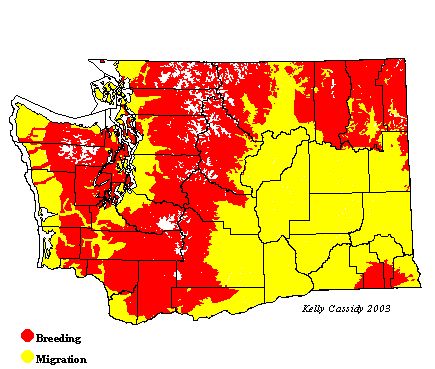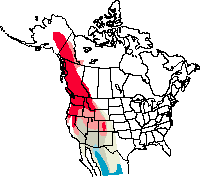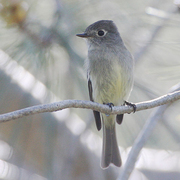Hammond's Flycatcher
General Description
Like other Empidonax flycatchers, Hammond's Flycatchers are olive-gray above and buffy-yellow below, with a slight crest, two white wing-bars, and white eye-ring. The eye-ring of the Hammond's is uneven and almost invisible in some birds. The bill is dark, which may help distinguish it from other Empidonax flycatchers. These small flycatchers have long wings, a relatively short tail, and very small bill.
Habitat
Regardless of the time of year, Hammond's Flycatchers inhabit cool, forested regions. During the breeding season, they use large stands of mature, wet conifer and mixed forests with closed canopies and sparse understories.
Behavior
These aerial foragers are found high in the canopy where they watch from a perch and fly out to catch prey in mid-air, then return to the perch to eat. They sometimes forage from lower perches, gleaning prey directly off the foliage, or hunting on the ground. The last two foraging styles are more common early in the breeding season. Both Hammond's and the similar Dusky Flycatchers wag their tails in a slow, up-down motion. (This behavior may help narrow down the choices when trying to distinguish among the Empidonax flycatchers).
Diet
Insects, especially beetles, caterpillars, moths, and flies, are the most common prey.
Nesting
The male sings to defend a territory and attract a mate. The female builds the nest, which is generally in the lower third of the canopy of a tall conifer, placed well out from the trunk on a horizontal branch. The nest is made of spider webs, grass, and plant fiber, lined with feathers and fur. The female incubates three to four eggs for 15 to 16 days, and broods the newly hatched young. Both parents help feed the young, which begin to fly at 16 to 18 days. The young often remain together, near the parents, for a week or so after they fledge.
Migration Status
These hardy birds undertake a prolonged migration in the fall and spring. They start arriving in Washington by mid-April, but many higher-altitude breeders remain in the lowlands until early to mid-May, arriving in Washington in late May. They start heading south again by mid-August, with the last birds leaving in late September. They winter in the pine-oak woods of Mexico and Central America.
Conservation Status
Hammond's Flycatchers were once common in the Puget Sound lowlands and the lowland forests on the eastern side of the Cascades, but extensive cutting of these forests has removed this habitat. They are listed on the Audubon~Washington watch list, although Breeding Bird Survey results indicate they have been increasing significantly in Washington in recent years. Some researchers have recommended, based on habitat requirement studies, that Hammond's Flycatchers need stands at least 20 acres in size and 80-90 years old to sustain populations.
When and Where to Find in Washington
Hammond's Flycatchers can be found from late April to August throughout Washington where there is appropriate habitat. They breed in wet coniferous forests, from the lowlands to the tree line, although they are most common at middle elevations. During migration they are common in the lowlands, including wooded areas of the shrub-steppe zone.
 Abundance
Abundance
| Ecoregion | Jan | Feb | Mar | Apr | May | Jun | Jul | Aug | Sep | Oct | Nov | Dec |
|---|---|---|---|---|---|---|---|---|---|---|---|---|
| Oceanic | ||||||||||||
| Pacific Northwest Coast | R | F | F | F | F | |||||||
| Puget Trough | U | F | U | U | F | F | ||||||
| North Cascades | R | C | C | C | F | R | ||||||
| West Cascades | R | F | F | F | F | U | ||||||
| East Cascades | R | F | F | F | F | F | R | |||||
| Okanogan | C | C | C | C | U | |||||||
| Canadian Rockies | F | F | F | F | ||||||||
| Blue Mountains | R | F | F | F | U | U | ||||||
| Columbia Plateau | U | U | U |
Washington Range Map

North American Range Map


Family Members
 Olive-sided FlycatcherContopus cooperi
Olive-sided FlycatcherContopus cooperi Western Wood-PeweeContopus sordidulus
Western Wood-PeweeContopus sordidulus Alder FlycatcherEmpidonax alnorum
Alder FlycatcherEmpidonax alnorum Willow FlycatcherEmpidonax traillii
Willow FlycatcherEmpidonax traillii Least FlycatcherEmpidonax minimus
Least FlycatcherEmpidonax minimus Hammond's FlycatcherEmpidonax hammondii
Hammond's FlycatcherEmpidonax hammondii Gray FlycatcherEmpidonax wrightii
Gray FlycatcherEmpidonax wrightii Dusky FlycatcherEmpidonax oberholseri
Dusky FlycatcherEmpidonax oberholseri Western FlycatcherEmpidonax difficilis
Western FlycatcherEmpidonax difficilis Black PhoebeSayornis nigricans
Black PhoebeSayornis nigricans Eastern PhoebeSayornis phoebe
Eastern PhoebeSayornis phoebe Say's PhoebeSayornis saya
Say's PhoebeSayornis saya Vermilion FlycatcherPyrocephalus rubinus
Vermilion FlycatcherPyrocephalus rubinus Ash-throated FlycatcherMyiarchus cinerascens
Ash-throated FlycatcherMyiarchus cinerascens Tropical KingbirdTyrannus melancholicus
Tropical KingbirdTyrannus melancholicus Western KingbirdTyrannus verticalis
Western KingbirdTyrannus verticalis Eastern KingbirdTyrannus tyrannus
Eastern KingbirdTyrannus tyrannus Scissor-tailed FlycatcherTyrannus forficatus
Scissor-tailed FlycatcherTyrannus forficatus Fork-tailed FlycatcherTyrannus savana
Fork-tailed FlycatcherTyrannus savana

